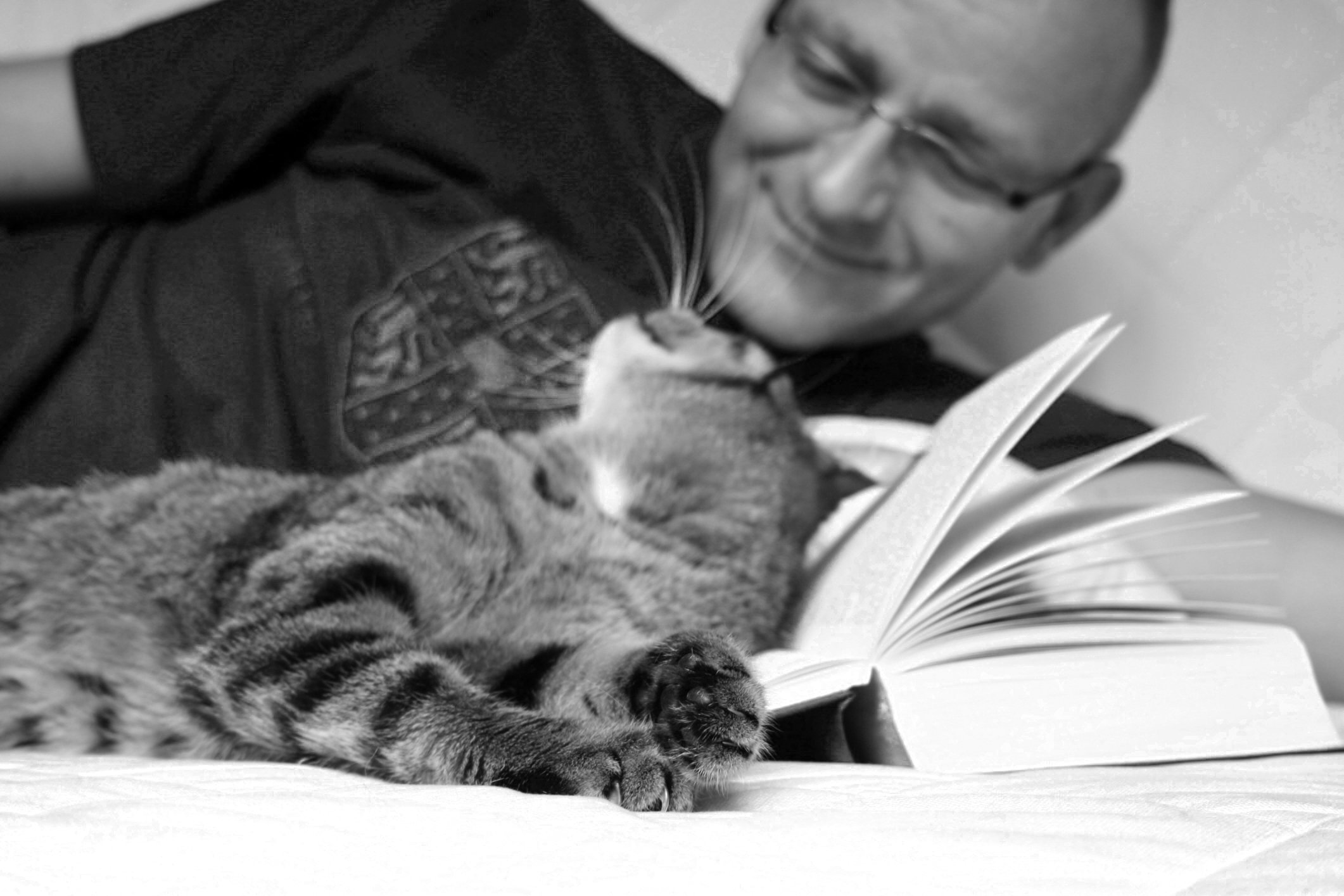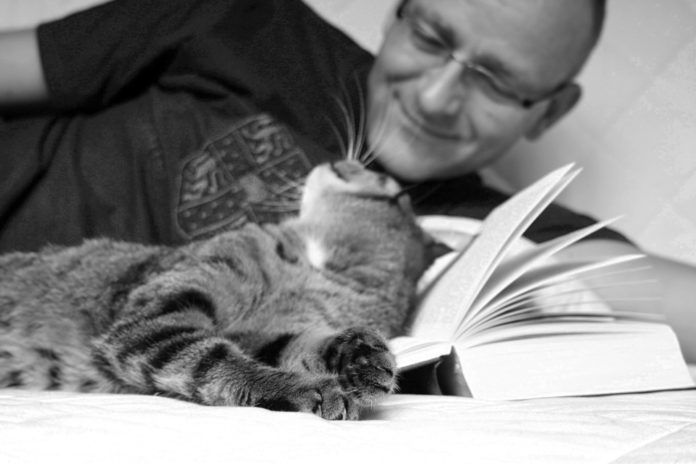When you’re walking around the house, he’s weaving tight figure eights around your legs. If you’re trying to take a catnap or watch some prime-time television, he’s happily draped across your neck, purring away. When you close the bedroom door at night to get some well-deserved sleep, he claws at the door and wails piteously. And he’s always between you and whatever you’re trying to read or eat.
Thinkstock

Is this behavior simply too much love — or is it something more troubling? To many cat owners, extreme displays of feline affection can be cute. But clinginess and overdependence can also be annoying, obnoxious and even hazardous: Chronic ankle weaving can lead to serious falls, while persistent face-pawing can get you a claw in the eye.
There are also emotional and psychological dangers for the clingy cat. A cat who becomes overly dependent on his owner’s constant presence can be at risk for serious depression, and even illness, if the owner has to be away for any length of time. Some cats even refuse to eat unless their favorite human is present in the room.
The start of separation anxiety
According to Nicholas Dodman, BVMS, Director of the Animal Behavior Clinic at Tufts Cummings School of Veterinary Medicine, chronic clinginess can lead to full-blown separation anxiety. The constant stress of separation anxiety not only puts your cat at risk for illness, but also makes his quality of life marginal at best.
Additionally, extreme clingy behavior can erode your mutual bond — just when your cat is feeling most needy and insecure. The annoyance caused by the constant attention of an obsessively clingy cat can cause even the most loving owner to back away.
Currently, there’s no scientific evidence that cats of any particular breed or gender have a greater tendency towards clinginess. Each cat is an individual, with a unique way of handling stress, major life changes and the ups and downs of daily life. Differences in temperament, sensitivity, tolerance and tendency towards anxiety can predispose any cat to clinginess, but the cat’s environment and upbringing tend to be more telling than any genetic predisposition.
Early indicators to consider
Some owners and behaviorists report that cats weaned too early, cats who were taken from their mothers when very young and cats who experienced traumatic or difficult early lives are more at risk for lifelong clinginess, fearful behavior and separation anxiety. It’s also been reported that elderly cats suffering cognitive decline can become increasingly clingy as they lose sensory sharpness and become more easily confused and disoriented.
But feline clinginess has seldom been studied scientifically, and owners with clingy cats seldom seek out professional behavioral help for their cats. According to Dr. Dodman, many owners actually enjoy their clingy cats! To some, clinginess can make some humans feel wanted, needed and loved. But ignoring or tolerating chronic overdependence can sometimes be unwise.
No matter how much you’re flattered and gratified by your cat’s clinginess, you should help him develop a healthy degree of independence and resilience. A strong, independent, emotionally resilient cat is much better prepared for whatever life changes come his way.
So, what should you do when your human-feline bond goes from comfortably close to claustrophobic? Start by looking at your cat’s behavioral patterns. Any sudden or significant change in your cat’s behavior or habits calls for a timely veterinary checkup to rule out possible medical issues. An independent feline who’s suddenly in your face at all hours may feel ill or be in pain.
And it always pays to listen —really listen — to your cat. A usually placid feline who suddenly insists on being heard may be trying to tell you something important. In fact, many lives have been saved when the family pet has alerted them to a house fire or other peril.
Prevention is key
As with any other feline behavior issue, prevention is much easier than trying to change clingy behavior. Happily, the ideal way to prevent clinginess and separation anxiety is actually quite simple: “Indulge them when they’re young and they will grow up independent,” says Dr. Dodman, the author of The Cat Who Cried for Help.
A cat who feels secure, safe and loved from his earliest days will most likely never feel the need to engage in obsessive clinginess. While monitoring his behavior to discourage bad habits, you should allow your kitten to enjoy as much contact with you as he wants.
Encourage closeness through daily interactive play, while fostering healthy independence by providing a selection of solo toys. Unless you suffer from allergies or have some other compelling reason to keep your cat out of your bedroom, allow him to sleep with you.
Reducing clinginess
Happily, there’s actually a lot you can do to help even the clingiest cat develop a healthy measure of independence and resilience. Let’s start with what not to do. Because clinginess stems from insecurity, avoid anything that will make your cat feel more insecure. Pushing your cat away, yelling at him, locking him away from you and the rest of his family, punishing him in any way — all these can make an unfortunate situation worse. Although it may seem counter-intuitive, often the best response when your clingy cat demands attention is … to give in.
Many times, a short, intense burst of interaction will satisfy your cat’s immediate need for reassurance. Indulgence, paradoxically, actually fosters independence. So, rather than pushing your cat away, stop what you’re doing and give him your full attention for a few minutes. Here are some other ways to help your cat become more independent and secure:
Stop making a big fuss when you leave the house. Keep departures and arrivals low-key.
Ignore behaviors you want to discourage, while rewarding behaviors you want to encourage. If his constant yowling has no effect on you, chances are that your cat will stop doing it. (Be consistent; this may take a lot of patience!)
Always be patient and gentle with your cat, no matter how busy you are or how persistently he annoys you. Try not to yell at him.
Rather than trying to stop a particular behavior, be ready with an enticing distraction (for example, tossing a solo toy across the room).
You can also redesign your cat’s living space to provide him with the closeness to you that he craves. For example, set up a tall cat tree right next to your desk, or a “kitty inbox” (a cat bed) right on your desk. Your clingy cat will find this privileged spot reassuring. Set up a second cat bed on or right next to your bed.
Separate bedrooms?
Some especially clingy cats are so persistently vocal and active throughout the night that their owners can become sleep-deprived. Ordinarily, it’s unwise to shut an already insecure cat away from his beloved people. But if your cat just won’t let you sleep, set up a private room with everything he needs for comfort and convenience. Each evening, at about the same time, conduct an interactive play session, offer some tasty treats and perform your reassuring “good night” ritual.
In his room, turn on a radio at low volume. Close the door. And — most importantly — ignore any further entreaties. Once your cat understands you’re serious, he’ll eventually settle in for the night. Consistency is vital, though. It may take several days before your cat settles into the new routine.
Thinkstock

Environmental enrichment
According to Nicole Cottam, MS, associate CAAB, Behavior Service Coordinator for the Cummings School, environmental enrichment is a major component to reducing a clingy cat’s stress and insecurity. Look around your house and devise ways to configure your home for maximum feline interest and pleasure.
Add features that will encourage your cat to gradually feel more independent, engaged and secure. The more in control of his environment your cat feels, the more independent and resilient he will feel. Here are some feline-friendly features that Ms. Cottam recommends:
– Bird feeders outside windows, with cozy window perches.
– An aquarium of colorful fish.
– Pots of “cat grass” for nibbling.
– A toy box filled with a regularly rotated assortment of toys.
– Treat balls and other food puzzles that provide stimulation and offer rewards for an enterprising cat.
– Cat tunnels, forts and mazes.
– Cat trees and climbing posts, strategically placed for stimulating window views.
– An assortment of comfortable beds and perches placed close to where the owner works or spends time (for example, near your desk or favorite chair).
– “Kitty videos” featuring live birds and bugs.
– A radio playing softly.
– One or more compatible feline companions.
– Help for tough cases
Even with plenty of extra attention and an enriched environment, some cats will still persist in extreme clingy behavior. For these cats, a course of anti-anxiety medication can help. It’s important to understand that these medications are not “cure-alls,” but tools to help a cat’s anxiety and insecurity while he’s learning new, more appropriate patterns of behavior.
Your veterinarian can determine the best strategy and medication for your individual cat. Ask lots of questions, and be sure you understand the possible risks as well as benefits. — Wendy Christensen




